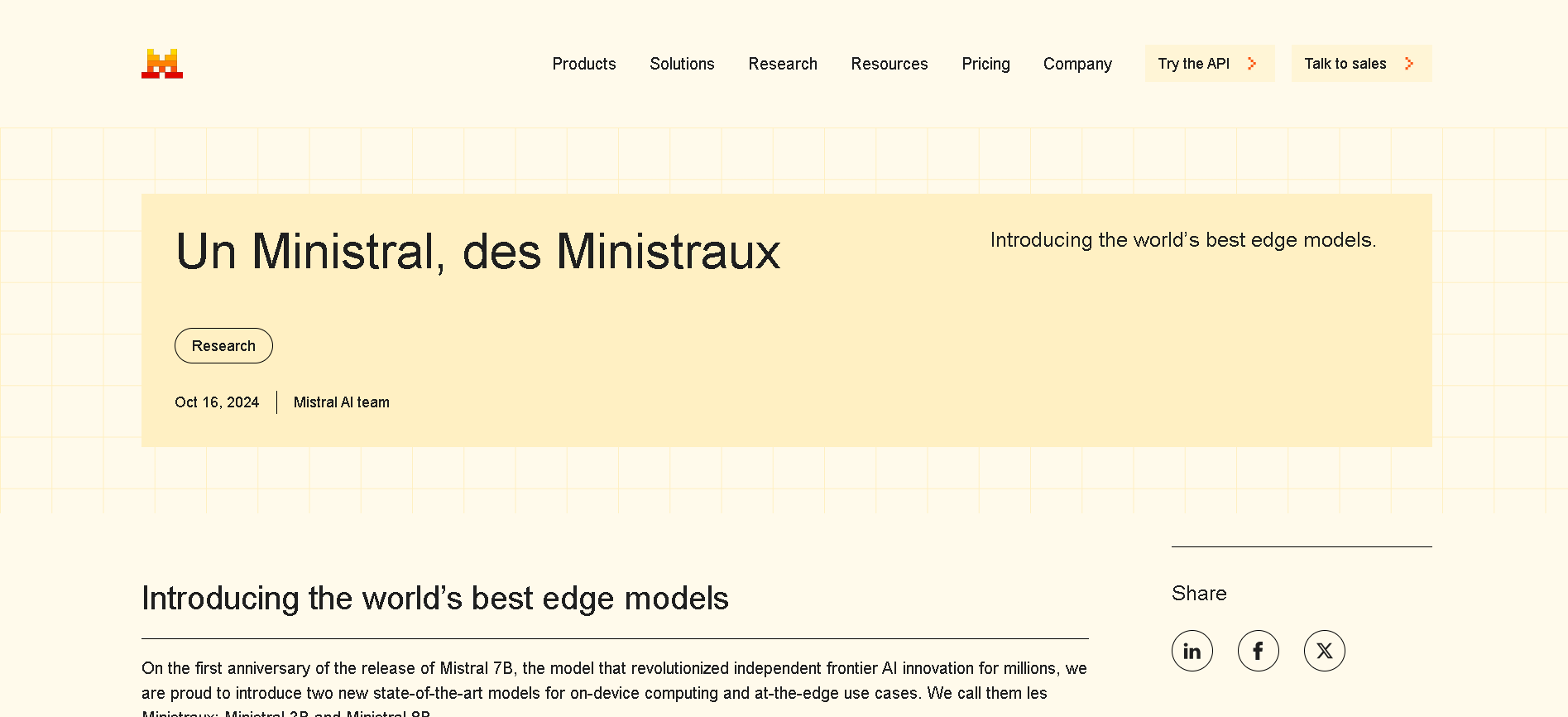
- Edge & On-Device Developers: Build local intelligence agents for translation, assistants, or robotics with low latency.
- AI Engineers & Teams: Deploy efficient, capable reasoning models on consumer-grade GPUs (~24GB).
- Researchers & Benchmarkers: Use the instruct-tuned variant for robust chain-of-thought and function-calling tasks.
- Enterprises & Startups: Use the API-priced version for workflows needing high performance at low cost.
- Open-Source Advocates: Work with weights under Mistral Research License and tune for specialized needs.
How to Use Ministral 8B?
- Choose the Model: Use `ministral-8b-latest` via Mistral’s API or Hugging Face model card.
- Deploy via vLLM or Mistral-Inference: Recommended setups for local inference; vLLM currently supports 32K context.
- Implement Instruct Prompts: Use Mistral’s V3-Tekken template for user-assistant prompts; supports function calling.
- Optimize Inference: Use interleaved attention for memory efficiency and quantize to fit hardware constraints.
- Use in Production: API access at $0.10/million tokens; commercial license available for self-deployment.
- Edge-Class Efficiency: Designed for on-device use with low latency and efficient memory.
- Massive Context: Handles up to 128K tokens, supporting long input scenarios.
- Top-Small Model Performance: Achieves instruct scores of ~70.9 Arena, 76.8 HumanEval, and 54.5 on math—leading in the 8B category.
- Function Calling: Connects to external tools, enabling rich agentic workflows.
- Cost-Effective: At $0.10 per million tokens, it offers one of the best performance-to-cost ratios.
- High-quality instruct and benchmark performance in 8B size
- Supports long-context tasks with 128K tokens
- Efficient for edge and on-device deployment
- Function-calling enables agentic and tool-based applications
- Accessible API pricing with commercial license options
- vLLM limits context to 32 K until full support arrives
- Performance slightly lower than larger models in some coding tasks
- Research license may restrict some commercial use—requires separate commercial license
API only
$0.1/$0.1 per 1M tokens
$0.1 per 1M output tokens
Proud of the love you're getting? Show off your AI Toolbook reviews—then invite more fans to share the love and build your credibility.
Add an AI Toolbook badge to your site—an easy way to drive followers, showcase updates, and collect reviews. It's like a mini 24/7 billboard for your AI.
Reviews
Rating Distribution
Average score
Popular Mention
FAQs
Similar AI Tools
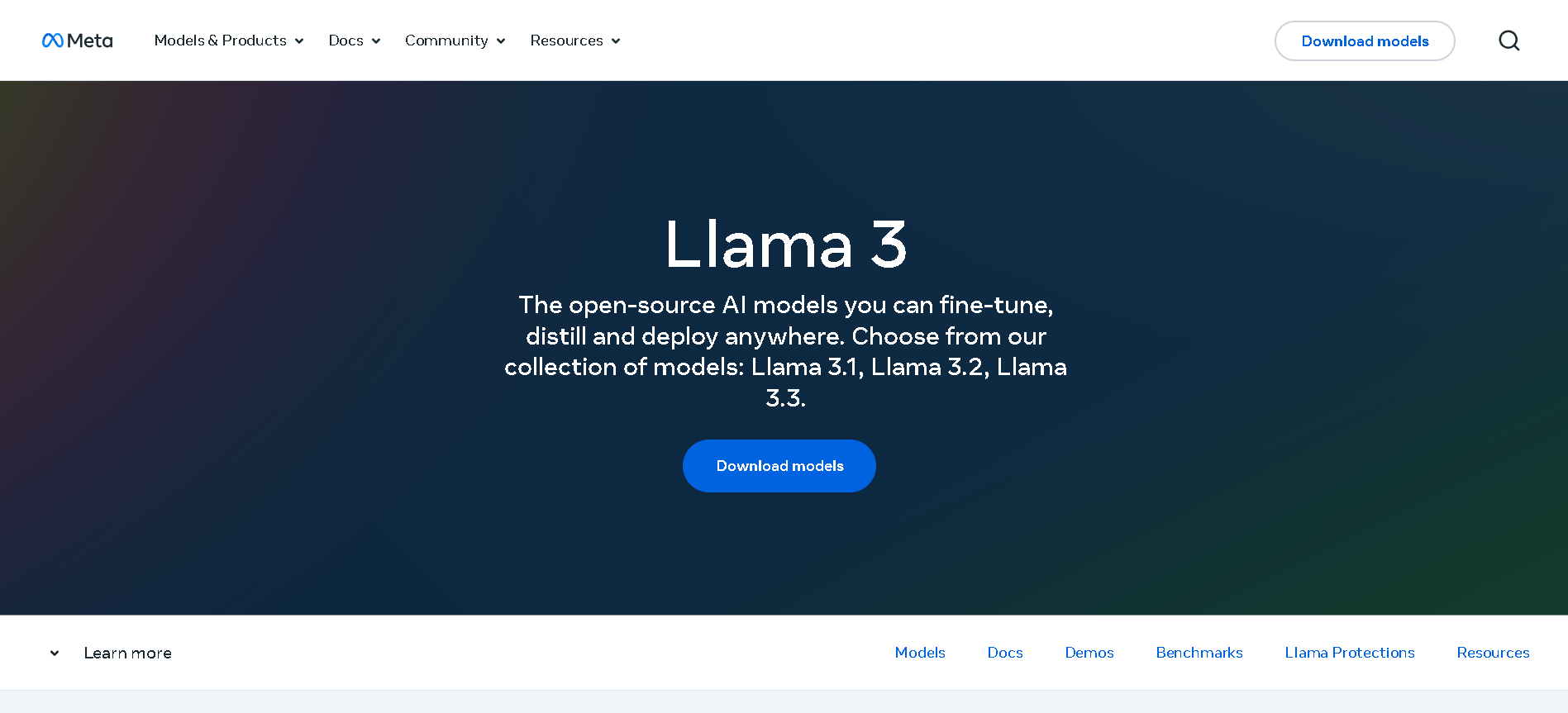

Meta Llama 3.3
Llama 3.3 is Meta’s instruction-tuned, text-only large language model released on December 6, 2024, available in a 70B-parameter size. It matches the performance of much larger models using significantly fewer parameters, is multilingual across eight key languages, and supports a massive 128,000-token context window—ideal for handling long-form documents, codebases, and detailed reasoning tasks.


Meta Llama 3.3
Llama 3.3 is Meta’s instruction-tuned, text-only large language model released on December 6, 2024, available in a 70B-parameter size. It matches the performance of much larger models using significantly fewer parameters, is multilingual across eight key languages, and supports a massive 128,000-token context window—ideal for handling long-form documents, codebases, and detailed reasoning tasks.


Meta Llama 3.3
Llama 3.3 is Meta’s instruction-tuned, text-only large language model released on December 6, 2024, available in a 70B-parameter size. It matches the performance of much larger models using significantly fewer parameters, is multilingual across eight key languages, and supports a massive 128,000-token context window—ideal for handling long-form documents, codebases, and detailed reasoning tasks.
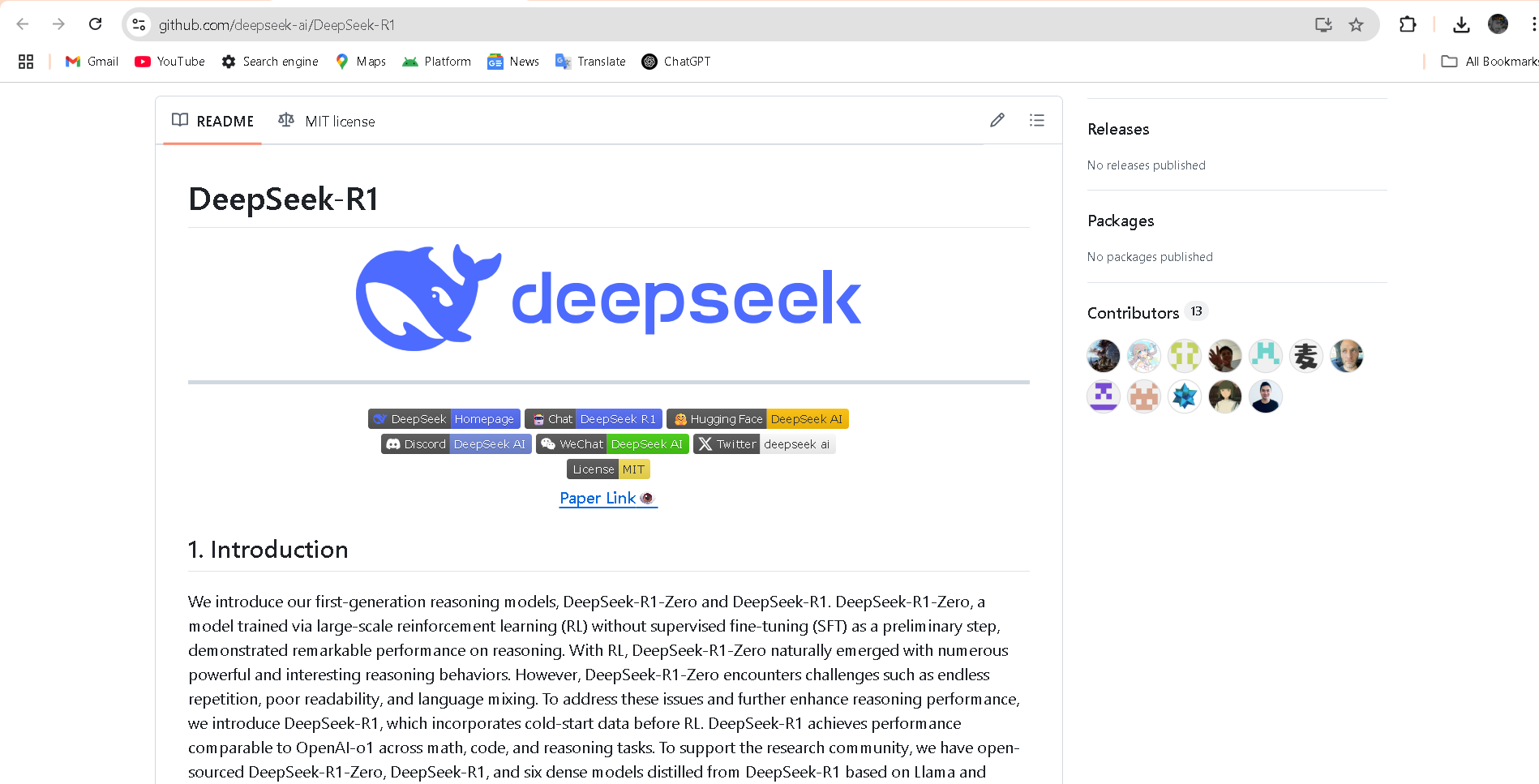
DeepSeek R1 Distill Qwen‑32B is a 32-billion-parameter dense reasoning model released in early 2025. Distilled from the flagship DeepSeek R1 using Qwen 2.5‑32B as a base, it delivers state-of-the-art performance among dense LLMs—outperforming OpenAI’s o1‑mini on benchmarks like AIME, MATH‑500, GPQA Diamond, LiveCodeBench, and CodeForces rating.


DeepSeek-R1-Distil..
DeepSeek R1 Distill Qwen‑32B is a 32-billion-parameter dense reasoning model released in early 2025. Distilled from the flagship DeepSeek R1 using Qwen 2.5‑32B as a base, it delivers state-of-the-art performance among dense LLMs—outperforming OpenAI’s o1‑mini on benchmarks like AIME, MATH‑500, GPQA Diamond, LiveCodeBench, and CodeForces rating.


DeepSeek-R1-Distil..
DeepSeek R1 Distill Qwen‑32B is a 32-billion-parameter dense reasoning model released in early 2025. Distilled from the flagship DeepSeek R1 using Qwen 2.5‑32B as a base, it delivers state-of-the-art performance among dense LLMs—outperforming OpenAI’s o1‑mini on benchmarks like AIME, MATH‑500, GPQA Diamond, LiveCodeBench, and CodeForces rating.
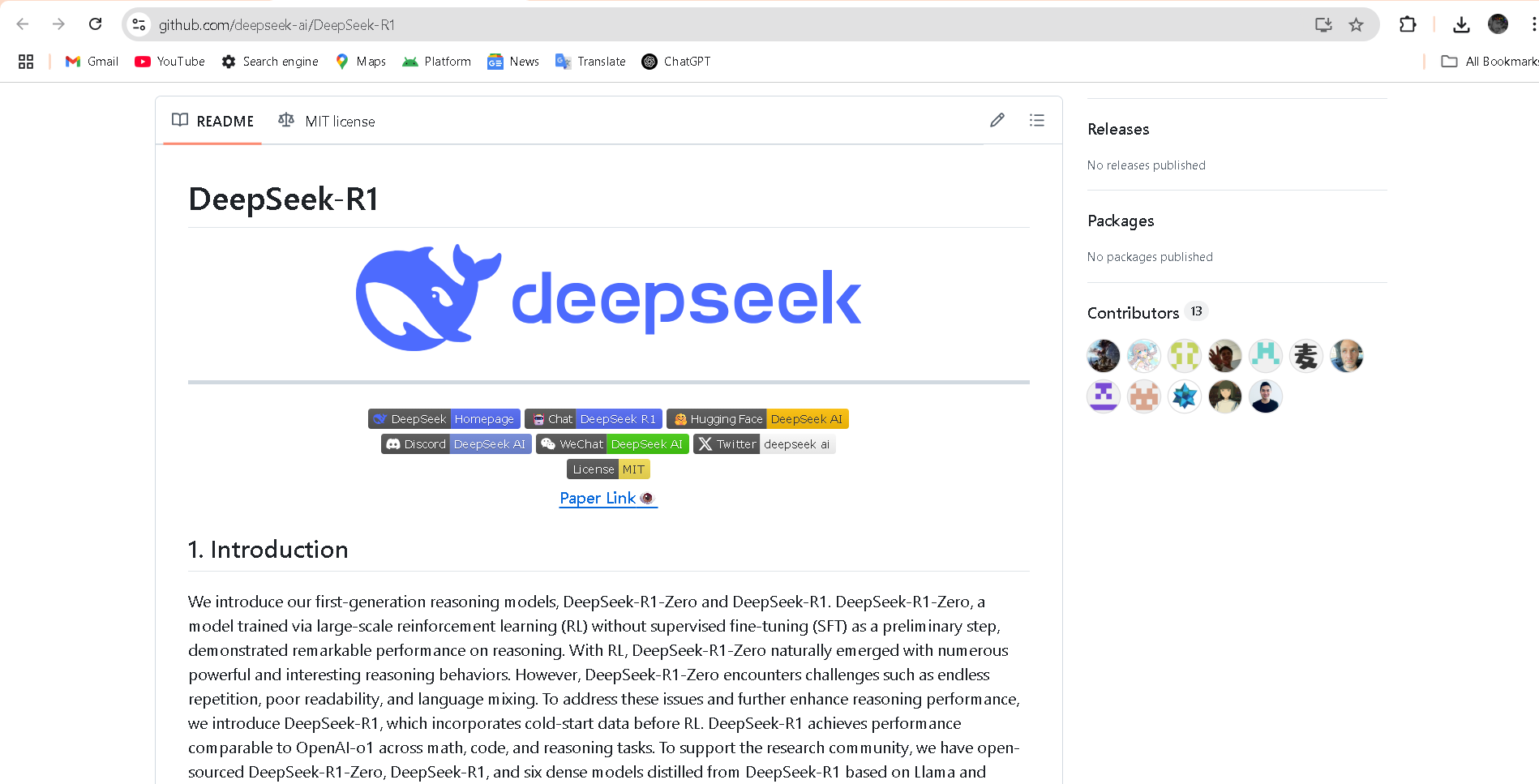

DeepSeek-R1-0528-Q..
DeepSeek R1 0528 – Qwen3 ‑ 8B is an 8 B-parameter dense model distilled from DeepSeek‑R1‑0528 using Qwen3‑8B as its base. Released in May 2025, it transfers high-depth chain-of-thought reasoning into a compact architecture while achieving benchmark-leading results close to much larger models.


DeepSeek-R1-0528-Q..
DeepSeek R1 0528 – Qwen3 ‑ 8B is an 8 B-parameter dense model distilled from DeepSeek‑R1‑0528 using Qwen3‑8B as its base. Released in May 2025, it transfers high-depth chain-of-thought reasoning into a compact architecture while achieving benchmark-leading results close to much larger models.


DeepSeek-R1-0528-Q..
DeepSeek R1 0528 – Qwen3 ‑ 8B is an 8 B-parameter dense model distilled from DeepSeek‑R1‑0528 using Qwen3‑8B as its base. Released in May 2025, it transfers high-depth chain-of-thought reasoning into a compact architecture while achieving benchmark-leading results close to much larger models.
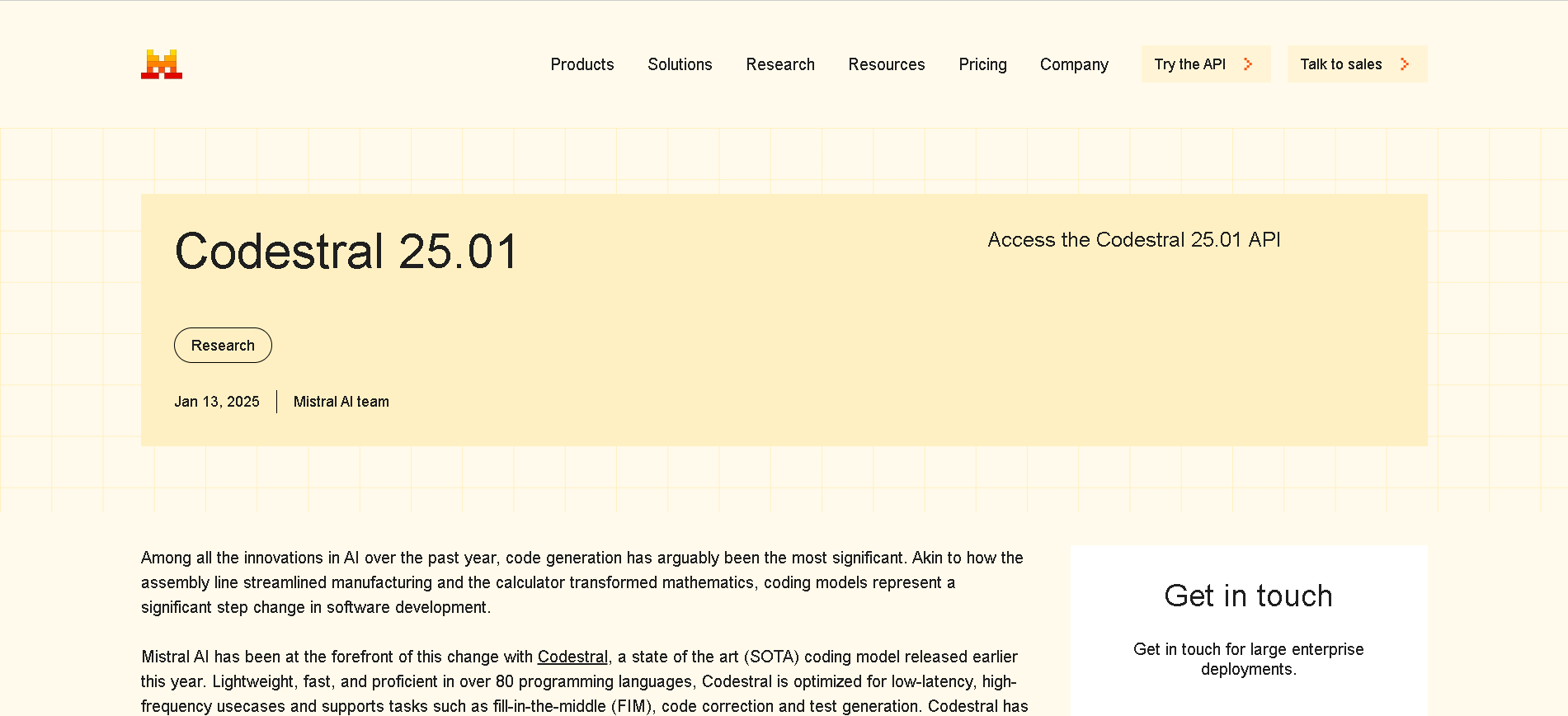
Mistral Codestral ..
Codestral 25.01 is Mistral AI’s upgraded code-generation model, released January 13, 2025. Featuring a more efficient architecture and improved tokenizer, it delivers code completion and intelligence about 2× faster than its predecessor, with support for fill-in-the-middle (FIM), code correction, test generation, and proficiency in over 80 programming languages, all within a 256K-token context window.

Mistral Codestral ..
Codestral 25.01 is Mistral AI’s upgraded code-generation model, released January 13, 2025. Featuring a more efficient architecture and improved tokenizer, it delivers code completion and intelligence about 2× faster than its predecessor, with support for fill-in-the-middle (FIM), code correction, test generation, and proficiency in over 80 programming languages, all within a 256K-token context window.

Mistral Codestral ..
Codestral 25.01 is Mistral AI’s upgraded code-generation model, released January 13, 2025. Featuring a more efficient architecture and improved tokenizer, it delivers code completion and intelligence about 2× faster than its predecessor, with support for fill-in-the-middle (FIM), code correction, test generation, and proficiency in over 80 programming languages, all within a 256K-token context window.
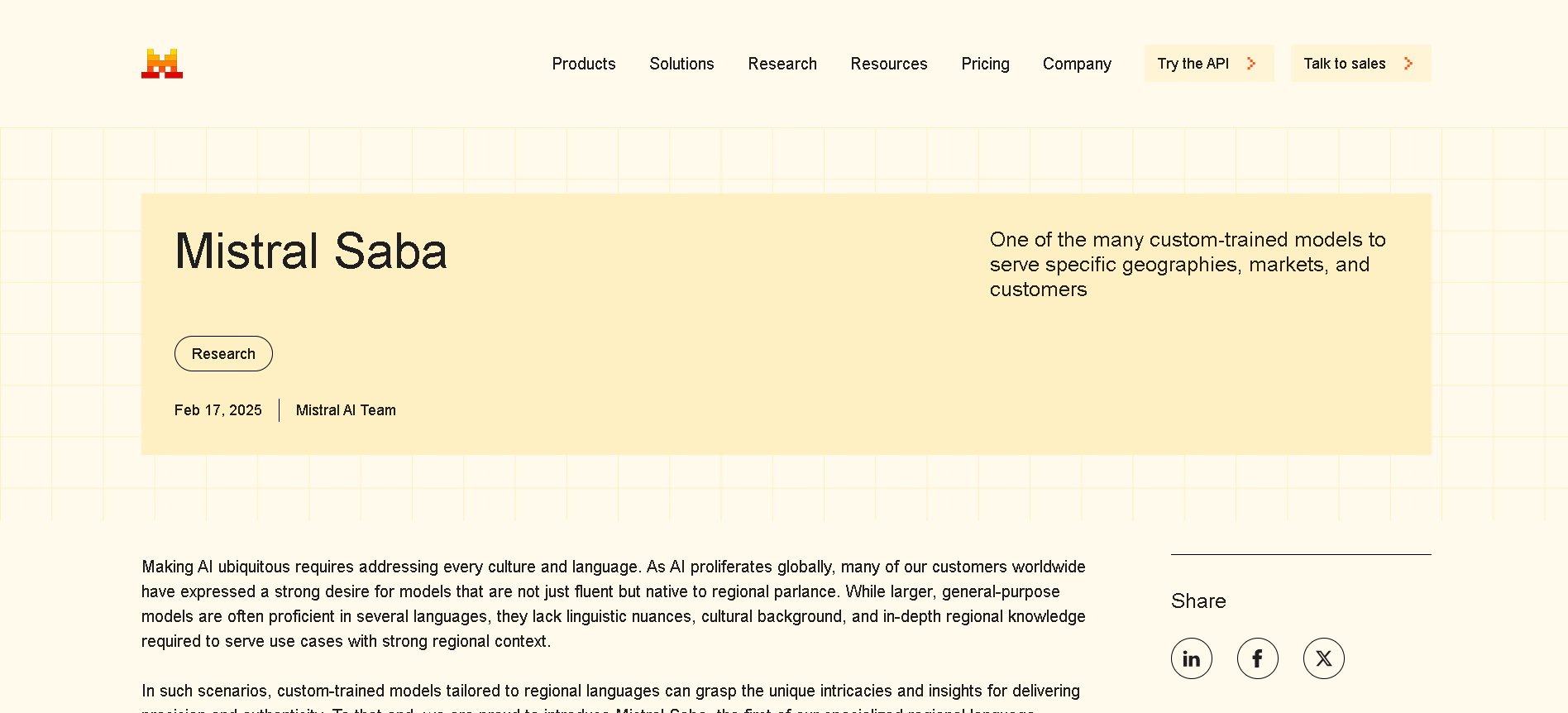
Mistral Saba
Mistral Saba is a 24 billion‑parameter regional language model launched by Mistral AI on February 17, 2025. Designed for native fluency in Arabic and South Asian languages (like Tamil, Malayalam, and Urdu), it delivers culturally-aware responses on single‑GPU systems—faster and more precise than much larger general models.

Mistral Saba
Mistral Saba is a 24 billion‑parameter regional language model launched by Mistral AI on February 17, 2025. Designed for native fluency in Arabic and South Asian languages (like Tamil, Malayalam, and Urdu), it delivers culturally-aware responses on single‑GPU systems—faster and more precise than much larger general models.

Mistral Saba
Mistral Saba is a 24 billion‑parameter regional language model launched by Mistral AI on February 17, 2025. Designed for native fluency in Arabic and South Asian languages (like Tamil, Malayalam, and Urdu), it delivers culturally-aware responses on single‑GPU systems—faster and more precise than much larger general models.
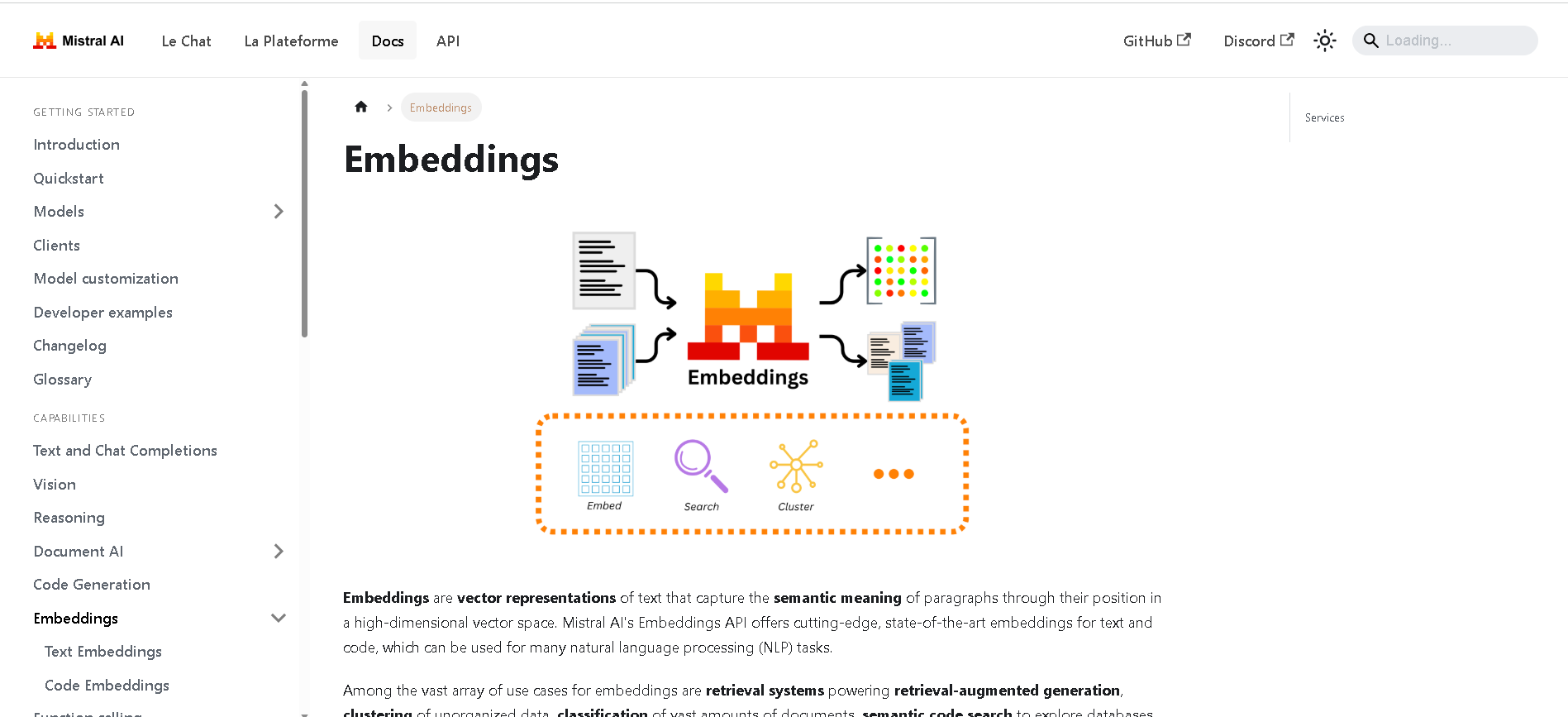
Mistral Embed
Mistral Embed is Mistral AI’s high-performance text embedding model designed for semantic retrieval, clustering, classification, and retrieval-augmented generation (RAG). With support for up to 8,192 tokens and producing 1,024-dimensional vectors, it delivers state-of-the-art semantic similarity and organization capabilities.

Mistral Embed
Mistral Embed is Mistral AI’s high-performance text embedding model designed for semantic retrieval, clustering, classification, and retrieval-augmented generation (RAG). With support for up to 8,192 tokens and producing 1,024-dimensional vectors, it delivers state-of-the-art semantic similarity and organization capabilities.

Mistral Embed
Mistral Embed is Mistral AI’s high-performance text embedding model designed for semantic retrieval, clustering, classification, and retrieval-augmented generation (RAG). With support for up to 8,192 tokens and producing 1,024-dimensional vectors, it delivers state-of-the-art semantic similarity and organization capabilities.
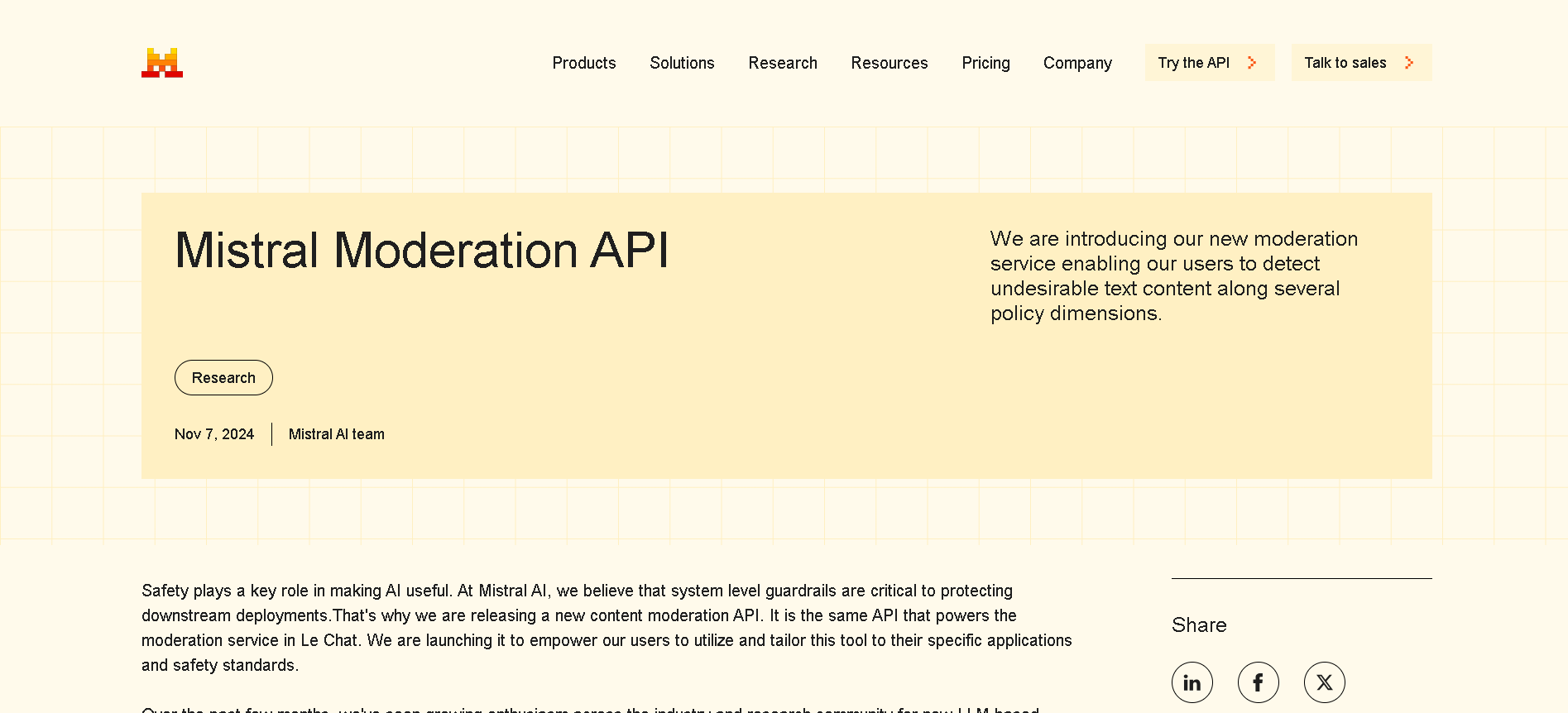
Mistral Moderation..
Mistral Moderation API is a content moderation service released in November 2024, powered by a fine-tuned version of Mistral’s Ministral 8B model. It classifies text across nine safety categories—sexual content, hate/discrimination, violence/threats, dangerous/criminal instructions, self‑harm, health, financial, legal, and personally identifiable information (PII). It offers two endpoints: one for raw text and one optimized for conversational content.

Mistral Moderation..
Mistral Moderation API is a content moderation service released in November 2024, powered by a fine-tuned version of Mistral’s Ministral 8B model. It classifies text across nine safety categories—sexual content, hate/discrimination, violence/threats, dangerous/criminal instructions, self‑harm, health, financial, legal, and personally identifiable information (PII). It offers two endpoints: one for raw text and one optimized for conversational content.

Mistral Moderation..
Mistral Moderation API is a content moderation service released in November 2024, powered by a fine-tuned version of Mistral’s Ministral 8B model. It classifies text across nine safety categories—sexual content, hate/discrimination, violence/threats, dangerous/criminal instructions, self‑harm, health, financial, legal, and personally identifiable information (PII). It offers two endpoints: one for raw text and one optimized for conversational content.
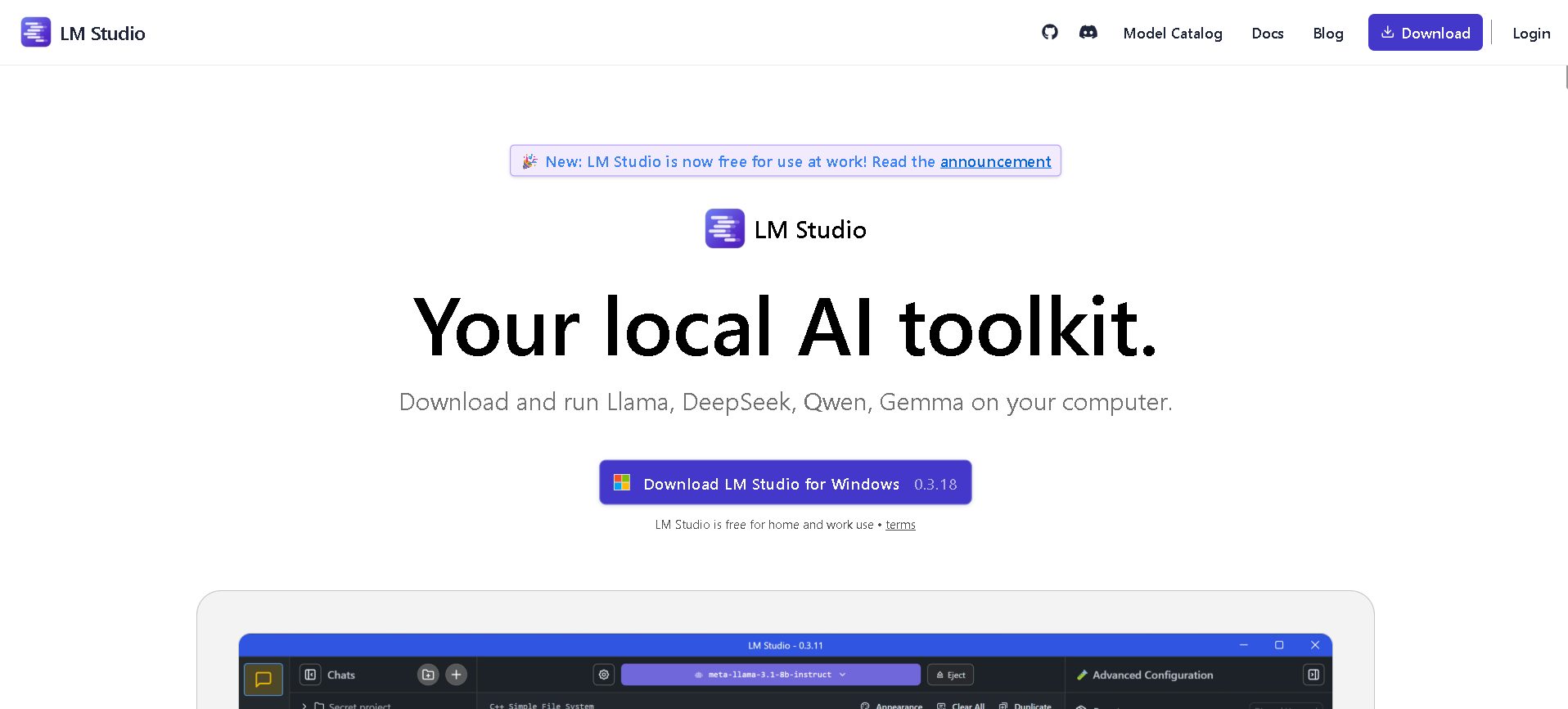

LM Studio
LM Studio is a local AI toolkit that empowers users to discover, download, and run Large Language Models (LLMs) directly on their personal computers. It provides a user-friendly interface to chat with models, set up a local LLM server for applications, and ensures complete data privacy as all processes occur locally on your machine.


LM Studio
LM Studio is a local AI toolkit that empowers users to discover, download, and run Large Language Models (LLMs) directly on their personal computers. It provides a user-friendly interface to chat with models, set up a local LLM server for applications, and ensures complete data privacy as all processes occur locally on your machine.


LM Studio
LM Studio is a local AI toolkit that empowers users to discover, download, and run Large Language Models (LLMs) directly on their personal computers. It provides a user-friendly interface to chat with models, set up a local LLM server for applications, and ensures complete data privacy as all processes occur locally on your machine.
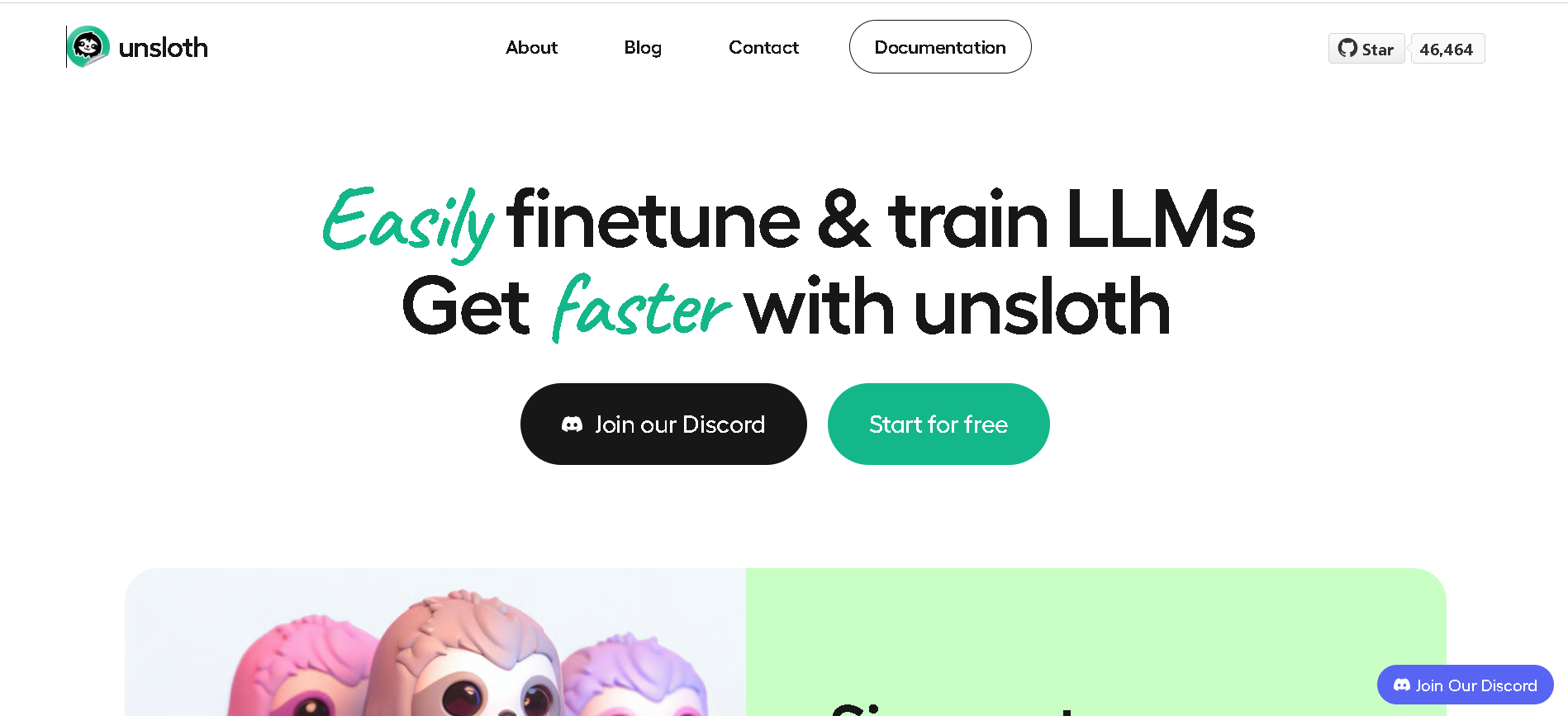

Unsloth AI
Unsloth.AI is an open-source platform designed to accelerate and simplify the fine-tuning of large language models (LLMs). By leveraging manual mathematical derivations, custom GPU kernels, and efficient optimization techniques, Unsloth achieves up to 30x faster training speeds compared to traditional methods, without compromising model accuracy. It supports a wide range of popular models, including Llama, Mistral, Gemma, and BERT, and works seamlessly on various GPUs, from consumer-grade Tesla T4 to high-end H100, as well as AMD and Intel GPUs. Unsloth empowers developers, researchers, and AI enthusiasts to fine-tune models efficiently, even with limited computational resources, democratizing access to advanced AI model customization. With a focus on performance, scalability, and flexibility, Unsloth.AI is suitable for both academic research and commercial applications, helping users deploy specialized AI solutions faster and more effectively.


Unsloth AI
Unsloth.AI is an open-source platform designed to accelerate and simplify the fine-tuning of large language models (LLMs). By leveraging manual mathematical derivations, custom GPU kernels, and efficient optimization techniques, Unsloth achieves up to 30x faster training speeds compared to traditional methods, without compromising model accuracy. It supports a wide range of popular models, including Llama, Mistral, Gemma, and BERT, and works seamlessly on various GPUs, from consumer-grade Tesla T4 to high-end H100, as well as AMD and Intel GPUs. Unsloth empowers developers, researchers, and AI enthusiasts to fine-tune models efficiently, even with limited computational resources, democratizing access to advanced AI model customization. With a focus on performance, scalability, and flexibility, Unsloth.AI is suitable for both academic research and commercial applications, helping users deploy specialized AI solutions faster and more effectively.


Unsloth AI
Unsloth.AI is an open-source platform designed to accelerate and simplify the fine-tuning of large language models (LLMs). By leveraging manual mathematical derivations, custom GPU kernels, and efficient optimization techniques, Unsloth achieves up to 30x faster training speeds compared to traditional methods, without compromising model accuracy. It supports a wide range of popular models, including Llama, Mistral, Gemma, and BERT, and works seamlessly on various GPUs, from consumer-grade Tesla T4 to high-end H100, as well as AMD and Intel GPUs. Unsloth empowers developers, researchers, and AI enthusiasts to fine-tune models efficiently, even with limited computational resources, democratizing access to advanced AI model customization. With a focus on performance, scalability, and flexibility, Unsloth.AI is suitable for both academic research and commercial applications, helping users deploy specialized AI solutions faster and more effectively.
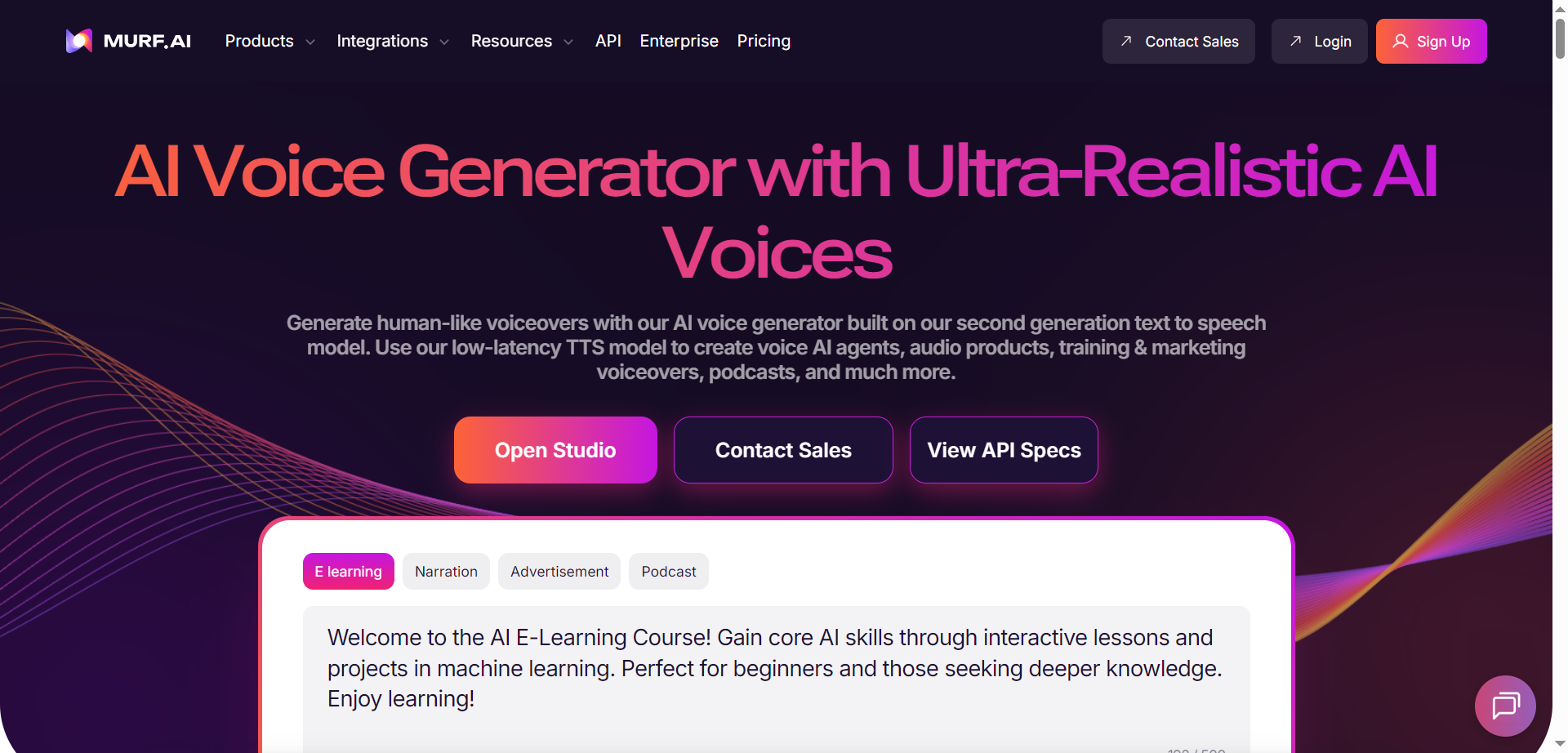

Murf.ai
Murf.ai is an AI voice generator and text-to-speech platform that delivers ultra-realistic voiceovers for creators, teams, and developers. It offers 200+ multilingual voices, 10+ speaking styles, and fine-grained controls over pitch, speed, tone, prosody, and pronunciation. A low-latency TTS model powers conversational agents with sub-200 ms response, while APIs enable voice cloning, voice changing, streaming TTS, and translation/dubbing in 30+ languages. A studio workspace supports scripting, timing, and rapid iteration for ads, training, audiobooks, podcasts, and product audio. Pronunciation libraries, team workspaces, and tool integrations help standardize brand voice at scale without complex audio engineering.


Murf.ai
Murf.ai is an AI voice generator and text-to-speech platform that delivers ultra-realistic voiceovers for creators, teams, and developers. It offers 200+ multilingual voices, 10+ speaking styles, and fine-grained controls over pitch, speed, tone, prosody, and pronunciation. A low-latency TTS model powers conversational agents with sub-200 ms response, while APIs enable voice cloning, voice changing, streaming TTS, and translation/dubbing in 30+ languages. A studio workspace supports scripting, timing, and rapid iteration for ads, training, audiobooks, podcasts, and product audio. Pronunciation libraries, team workspaces, and tool integrations help standardize brand voice at scale without complex audio engineering.


Murf.ai
Murf.ai is an AI voice generator and text-to-speech platform that delivers ultra-realistic voiceovers for creators, teams, and developers. It offers 200+ multilingual voices, 10+ speaking styles, and fine-grained controls over pitch, speed, tone, prosody, and pronunciation. A low-latency TTS model powers conversational agents with sub-200 ms response, while APIs enable voice cloning, voice changing, streaming TTS, and translation/dubbing in 30+ languages. A studio workspace supports scripting, timing, and rapid iteration for ads, training, audiobooks, podcasts, and product audio. Pronunciation libraries, team workspaces, and tool integrations help standardize brand voice at scale without complex audio engineering.
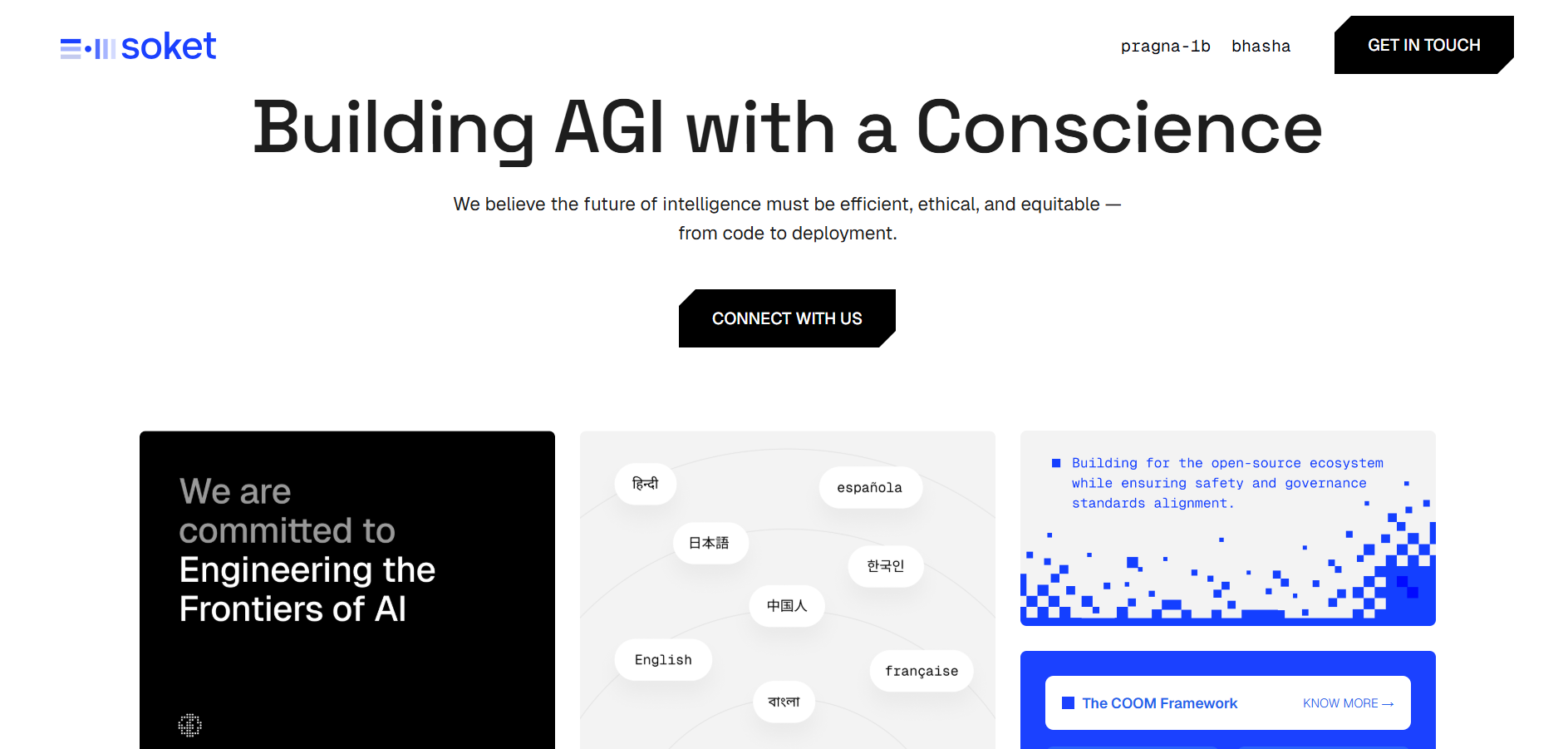

Soket AI
Soket AI is an Indian deep-tech startup building sovereign, multilingual foundational AI models and real-time voice/speech APIs designed for Indic languages and global scale. By focusing on language diversity, cultural context and ethical AI, Soket AI aims to develop models that recognise and respond across many languages, while delivering enterprise-grade capabilities for sectors such as defence, healthcare, education and governance.


Soket AI
Soket AI is an Indian deep-tech startup building sovereign, multilingual foundational AI models and real-time voice/speech APIs designed for Indic languages and global scale. By focusing on language diversity, cultural context and ethical AI, Soket AI aims to develop models that recognise and respond across many languages, while delivering enterprise-grade capabilities for sectors such as defence, healthcare, education and governance.


Soket AI
Soket AI is an Indian deep-tech startup building sovereign, multilingual foundational AI models and real-time voice/speech APIs designed for Indic languages and global scale. By focusing on language diversity, cultural context and ethical AI, Soket AI aims to develop models that recognise and respond across many languages, while delivering enterprise-grade capabilities for sectors such as defence, healthcare, education and governance.
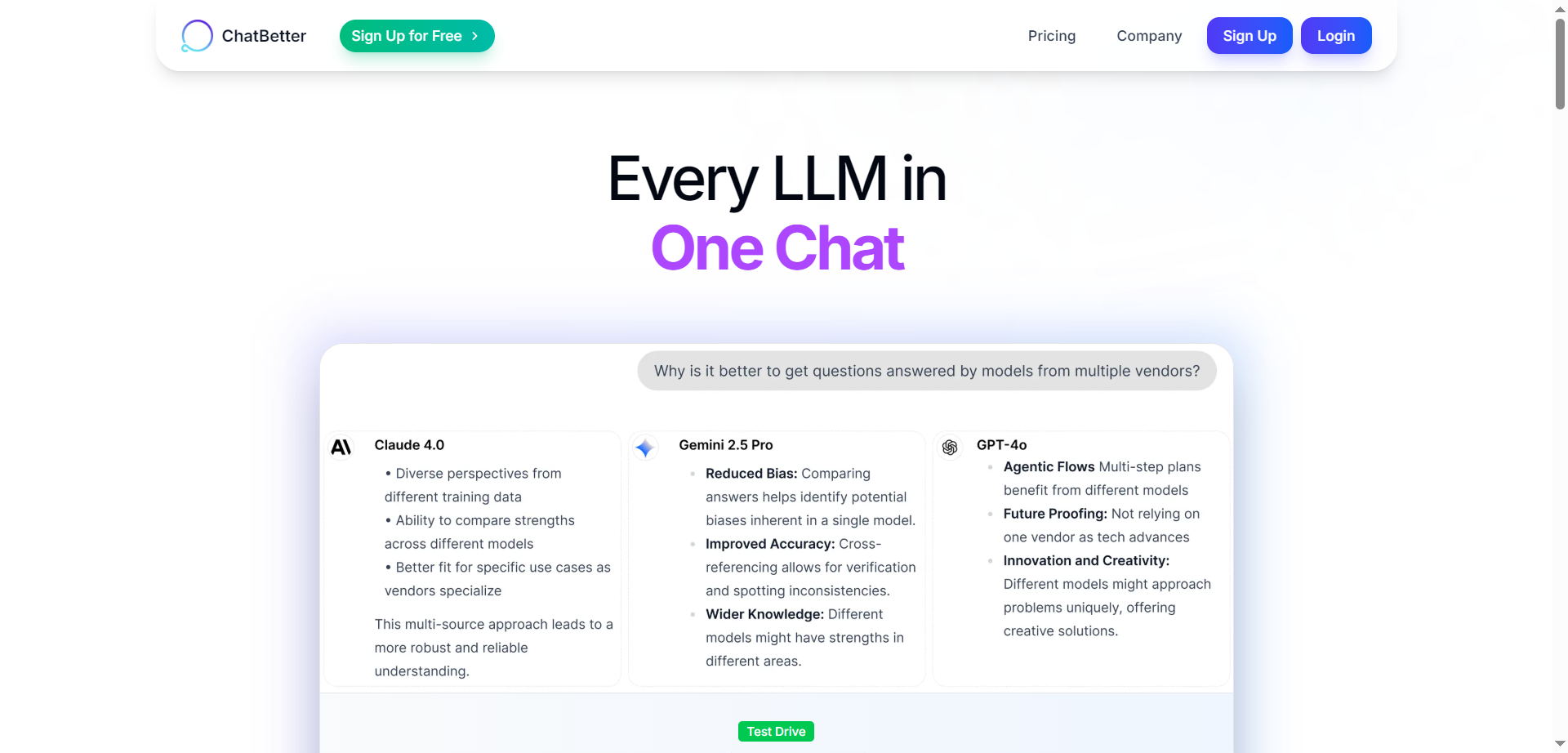
ChatBetter
ChatBetter is an AI platform designed to unify access to all major large language models (LLMs) within a single chat interface. Built for productivity and accuracy, ChatBetter leverages automatic model selection to route every query to the most capable AI—eliminating guesswork about which model to use. Users can directly compare responses from OpenAI, Anthropic, Google, Meta, DeepSeek, Perplexity, Mistral, xAI, and Cohere models side by side, or merge answers for comprehensive insights. The system is crafted for teams and individuals alike, enabling complex research, planning, and writing tasks to be accomplished efficiently in one place.

ChatBetter
ChatBetter is an AI platform designed to unify access to all major large language models (LLMs) within a single chat interface. Built for productivity and accuracy, ChatBetter leverages automatic model selection to route every query to the most capable AI—eliminating guesswork about which model to use. Users can directly compare responses from OpenAI, Anthropic, Google, Meta, DeepSeek, Perplexity, Mistral, xAI, and Cohere models side by side, or merge answers for comprehensive insights. The system is crafted for teams and individuals alike, enabling complex research, planning, and writing tasks to be accomplished efficiently in one place.

ChatBetter
ChatBetter is an AI platform designed to unify access to all major large language models (LLMs) within a single chat interface. Built for productivity and accuracy, ChatBetter leverages automatic model selection to route every query to the most capable AI—eliminating guesswork about which model to use. Users can directly compare responses from OpenAI, Anthropic, Google, Meta, DeepSeek, Perplexity, Mistral, xAI, and Cohere models side by side, or merge answers for comprehensive insights. The system is crafted for teams and individuals alike, enabling complex research, planning, and writing tasks to be accomplished efficiently in one place.
Editorial Note
This page was researched and written by the ATB Editorial Team. Our team researches each AI tool by reviewing its official website, testing features, exploring real use cases, and considering user feedback. Every page is fact-checked and regularly updated to ensure the information stays accurate, neutral, and useful for our readers.
If you have any suggestions or questions, email us at hello@aitoolbook.ai